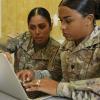Army commanders face significant decisions when trying to overcome challenges and solve problems. But too often, one of the best sources of information and insights remains unexplored or excluded from the decision-making process—data analytics.
In the early 2000s, as the Army expanded its combat operations in Iraq, commanders at echelon struggled to identify trends and gain insights into local, regional and national environments, to include trends in adversary activities. Hours were spent locating and consolidating disparate data sources (for example, surveys, Combined Information Data...
















